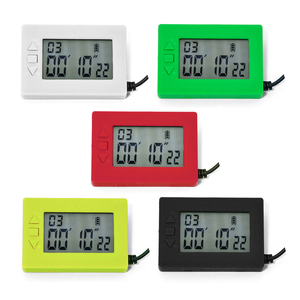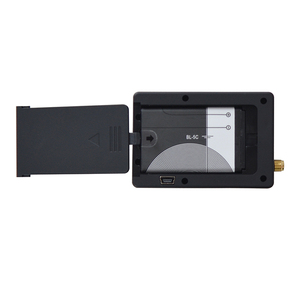(56 products available)















































































































































































GPS-based timers
GPS-based motorcycle lap timers use satellite signals to track the bike's precise location and speed. They are reliable for measuring lap times and providing real-time speed and position data. The timers can analyze the riding style and track where improvements are needed. These timers are excellent for racers wanting accuracy and data.
Data acquisition systems (DAS)
Data acquisition systems (DAS) in motorcycle lap timers are advanced technology. They gather detailed information about the bike and the rider during races. The timers track things like the bike's speed, where it is on the track, how hard the rider is pushing, how heated the bike's parts get, and how much gas is left. This information helps teams understand their performance better. It also helps them compare how well they do over time. With data acquisition systems, lap timers give a complete picture of racing performance.
Digital timers
Digital timers are simple and cost-effective solutions for tracking lap times in motorcycle sports. They feature easy-to-read digital displays that show current lap times and allow manual tracking by the rider or a pit crew member. Digital timers can often be adjusted to suit different tracks and race formats. While lacking advanced features like GPS or data logging, digital timers provide essential lap time tracking, making them accessible for amateur and club-level racers.
Bluetooth-enabled timers
Bluetooth-enabled motorcycle lap timers are timers that connect to smartphones or tablets using Bluetooth technology. This connection allows for real-time lap timing, analysis, and data sharing. Riders can track their performance during practice or races and analyze detailed data later. The Bluetooth feature enables live timing updates, control of the timer from the mobile device, and access to additional apps for data analysis and sharing. Bluetooth-enabled lap timers provide convenience and connectivity, enhancing overall performance tracking.
Customizable timers
Customizable motorcycle lap timers offer flexibility to set up according to individual needs and preferences. Users can adjust the display to show essential information like lap times, splits, and averages. They may also allow selecting the timing mode, such as practice or qualifying, and set alerts for certain laps or performance goals. Customizable timers enable riders to focus on critical aspects of their performance, providing a personalized experience and optimizing lap time tracking.
Regular Cleaning:
It is important to clean the motorcycle lap timer regularly. Dust and dirt can build up on the surface, which can affect how well it works. Use a soft cloth or brush to wipe away any debris. If there is sticky residue, use a cleaner made for electronics or a damp cloth. But don't use too much moisture so that it does not damage the internal parts.
Software Updates:
Many timers have computer programs that need to be kept up to date. Check the manufacturer's website or instructions for how to install updates. These updates can add new features or improve accuracy. Follow the steps carefully to download and install any available updates.
Battery Maintenance:
Take care of the motorcycle lap timer's battery. If the timer uses regular batteries, replace them with fresh ones when the timer indicates low power. If it has a rechargeable battery, follow the instructions on how to charge it properly. Only use the charger specified by the manufacturer. Avoid overcharging the battery, as this can shorten its lifespan.
Inspect Cables and Connectors:
If the timer has any cables or plugs, look for damage or looseness. Ensure the connections are secure. Frayed cables or loose plugs could cause the timer to stop working correctly. If any cables are damaged, replace them right away.
Temperature Considerations:
Some timers have a specified temperature range. If the timer is exposed to extreme heat or cold, it could affect performance. For example, leaving the timer on the bike's dashboard in direct sunlight can cause damage over time. Similarly, riding in very cold conditions may impact the battery's ability to hold a charge.
Shock and Vibration Precautions:
Lap timers are designed to endure some shock and vibration, but excessive jolts can harm them. Avoid mounting the timer in an area of the bike that experiences extreme vibration. Use padded or shock-absorbing mounts to protect the timer from rough handling.
Water Resistance:
If the timer is water-resistant, ensure all ports and covers are correctly sealed before riding in rain or wet conditions. Inspect gaskets and seals periodically to confirm they are not cracked or damaged, as this could allow moisture inside the device. If the timer is not water-resistant, remove it during wet weather or use a protective cover.
Follow Usage Guidelines:
Every timer has specific directions for using it correctly to get the most accurate results. Read through the manual carefully and take note of anything extra needed for proper functioning. This may include calibrating sensors, setting options, or following certain steps when using lap timing features.
Check for Physical Damage:
Periodically inspect the timer for any visible physical damage, such as cracks in the casing or a broken screen. If the timer is dropped or mishandled, it could lead to problems down the road. Handle the device with care to avoid accidents that could impact performance.
When retailing lap timers, it’s important to know what customers look for. Below are the key factors to consider when choosing motorcycle lap timers for sale.
Ease of use
First and foremost, buyers will want a device that is easy to set up and use. Complicated timers with complex buttons and difficult-to-read displays will frustrate riders and track enthusiasts. Opt for timers with intuitive interfaces and clear instructions. Backlit displays will enhance visibility in all lighting conditions.
Durability
Customers will want a durable motorcycle lap timer that can withstand extreme weather conditions and the rigors of track use. Choose timers made from robust materials with strong housings to resist impact and vibration. Waterproof and dustproof features will ensure reliable operation in diverse environments.
Accuracy and reliability
Accuracy is critical when measuring lap times. Select timers with high-precision GPS systems or advanced sensors for precise speed and position data. Reliability is equally important. Customers expect consistent performance without malfunctions or interruptions.
Data analysis
Many riders will want to analyze their performance data after the session. Opt for timers that allow data download for further analysis. Some advanced timers even offer real-time telemetry, providing instant feedback to teams and mechanics.
Battery life
Long battery life is essential, especially during extended track days or endurance races. Look for timers with energy-efficient designs and consider those with replaceable batteries for added convenience.
Additional features
Some motorcycle lap timers have extra features that can improve the overall experience. These include split time measurement, sector time tracking, and average speed calculation. Riders who value comprehensive performance metrics will appreciate these additions.
Mounting options
Flexibility in mounting options is essential for customers who want the timer mounted on different bike models. Timers with adjustable brackets, adhesive mounts, or even handlebar straps will ensure secure and convenient mounting.
Budget
Lastly, consider the budget. Motorcycle lap timers are available for all price ranges. Find a good balance between features, quality, and affordability to cater to different customer segments.
To replace a motorcycle lap timer, first, assemble the necessary tools: the new timer, screwdrivers, and possibly electrical tape. Start by turning off the bike and unplugging the old timer. Use screwdrivers to remove any screws holding the old timer in place. Carefully take out the old timer, being gentle not to damage the bike's parts. Place the new timer in the spot where the old one was. Secure it with screws. If there were any connections like electrical wires, make sure they are connected to the new timer. Double-check that everything is installed correctly. Then, take the bike for a short ride to ensure that the new timer is working properly. If it is, then the replacement was successful.
Q1: Do lap timers work for all types of motorcycles?
A1: Yes, lap timers can be used for all types of motorcycles. However, the functionality and setup may vary depending on the type of motorcycle and the specific timer model.
Q2: Can lap timers be used for off-road motorcycles?
A2: Yes, lap timers can be used for off-road motorcycles. This is especially useful for off-road events or practice sessions where tracking performance is important.
Q3: Are lap timers waterproof?
A3: Some motorcycle lap timers are waterproof or resistant to water splashes. This is important if riders need to use the timer in wet conditions or if they want to protect the device from rain.
Q4: Can lap timers be used for remote control motorcycles?
A4: Motorcycle lap timers are designed for use on full-size motorcycles. However, specific models can be used on remote control motorcycles, depending on the size and functionality of the timer.